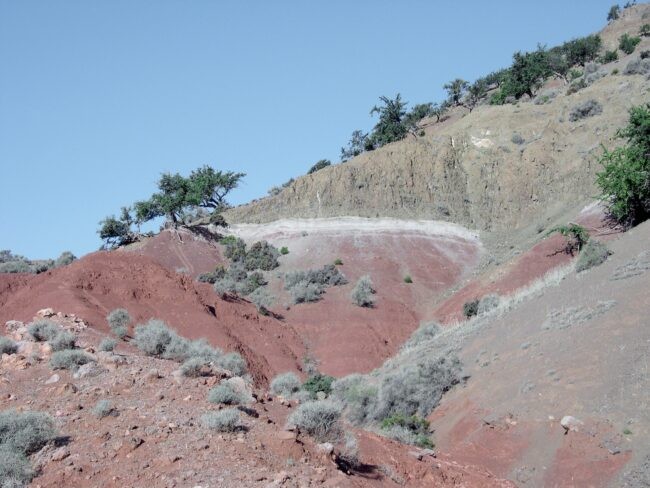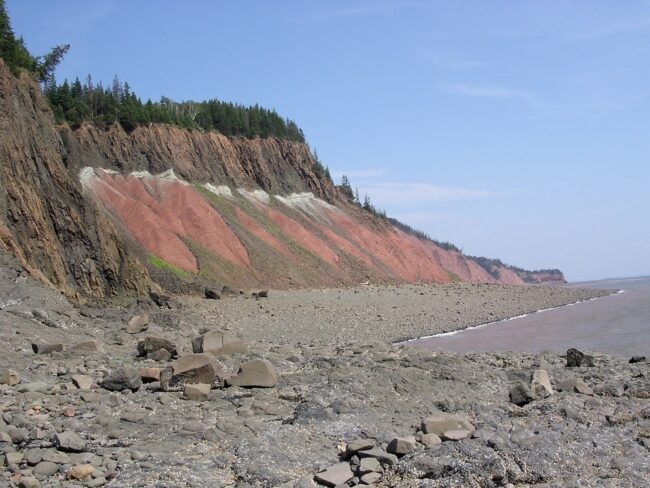2024-10-29 コロンビア大学

Above, deposits in Morocco associated with the Triassic-Jurassic mass extinction, 201.6 million years ago. Red sediments in many locations around the world contain Triassic-era fossils. The white band on top of them is where the sediments were altered by massive volcanism, as evidenced by the gray/black basalt layers topping the assemblage. In the photo below, nearly identical deposits along Nova Scotia’s Bay of Fundy record an eruption a few thousand years later. (Photos: Paul Olsen)

<関連情報>
- https://lamont.columbia.edu/news/dinosaurs-thrived-after-ice-not-fire-says-new-study-ancient-volcanism
- https://www.pnas.org/doi/10.1073/pnas.2415486121
- https://www.pnas.org/doi/10.1073/pnas.1309188110
中央大西洋マグマ地域の初期溶岩の数百年規模のパルスと三畳紀末の絶滅の相関性 Correlation of sub-centennial-scale pulses of initial Central Atlantic Magmatic Province lavas and the end-Triassic extinctions
Dennis V. Kent, Paul E. Olsen, Huapei Wang, +1, and Mohammed Et-Touhami
Proceedings of the National Academy of Sciences Published:October 28, 2024
DOI:https://doi.org/10.1073/pnas.2415486121
Significance
During the initial phase of eruptions, Central Atlantic Magmatic Province (CAMP) basalts spewed more than 500 times the amount of sulfur released during the Laki historic eruption in Iceland. The repeated injections of sulfate aerosols, constrained by paleosecular variation data, occurred in rapid succession. The resulting severe [albedo-induced] volcanic winters may have been the proximal cause for the well-resolved end-Triassic mass extinction in the continental realm. However, in the less temporally constrained marine realm, longer-term cumulative release of carbon dioxide from CAMP eruptive and intrusive activity may have played an important albeit somewhat diachronous role in the extinctions through ocean acidification and longer-term warming.
Abstract
The end-Triassic extinction (ETE) on land was synchronous with the initial lavas of the Central Atlantic Magmatic Province (CAMP) and occurred just after the brief 26 thousand year (kyr) reverse geomagnetic polarity Chron E23r that can be used for global correlation. Lava-by-lava paleomagnetic secular variation data, previously reported from Morocco and northeastern United States combined with our data for the North Mountain Basalt from the Fundy Basin of Canada show that the initial phase of CAMP volcanism occurred in only five directional groups or pulses each occupying less than a century. The first four directional groups occur during a ~40 kyr period based on available astrochronology and U-Pb geochronology. The coincidence of the initial major pulse of CAMP volcanism with the ETE points to short-lived volcanic winters albedo-induced by sulfate aerosols as a plausible key agent of the extinctions in the tropical continental realm, whereas looser correlations allow prolonged CO2 emissions to contribute to more long-ranging effects in the marine realm via ocean acidification and longer-term warming.
暁新世-始新世の熱極大期における炭素の急激な放出の証拠 Evidence for a rapid release of carbon at the Paleocene-Eocene thermal maximum
James D. Wright and Morgan F. Schaller
Proceedings of the National Academy of Sciences Published:September 16, 2013
DOI:https://doi.org/10.1073/pnas.1309188110

Significance
Calcium carbonate and carbon isotope records from the rhythmically bedded Marlboro Clay, deposited during the onset of the PETM CIE, show that the massive release of isotopically light carbon was instantaneous, providing important constraints for the magnitude of carbon released and potential mechanisms.
Abstract
The Paleocene/Eocene thermal maximum (PETM) and associated carbon isotope excursion (CIE) are often touted as the best geologic analog for the current anthropogenic rise in pCO2. However, a causal mechanism for the PETM CIE remains unidentified because of large uncertainties in the duration of the CIE’s onset. Here, we report on a sequence of rhythmic sedimentary couplets comprising the Paleocene/Eocene Marlboro Clay (Salisbury Embayment). These couplets have corresponding δ18O cycles that imply a climatic origin. Seasonal insolation is the only regular climate cycle that can plausibly account for δ18O amplitudes and layer counts. High-resolution stable isotope records show 3.5‰ δ13C decrease over 13 couplets defining the CIE onset, which requires a large, instantaneous release of 13C-depleted carbon. During the CIE, a clear δ13C gradient developed on the shelf with the largest excursions in shallowest waters, indicating atmospheric δ13C decreased by ∼20‰. Our observations and revised release rate are consistent with an atmospheric perturbation of 3,000-gigatons of carbon (GtC).



